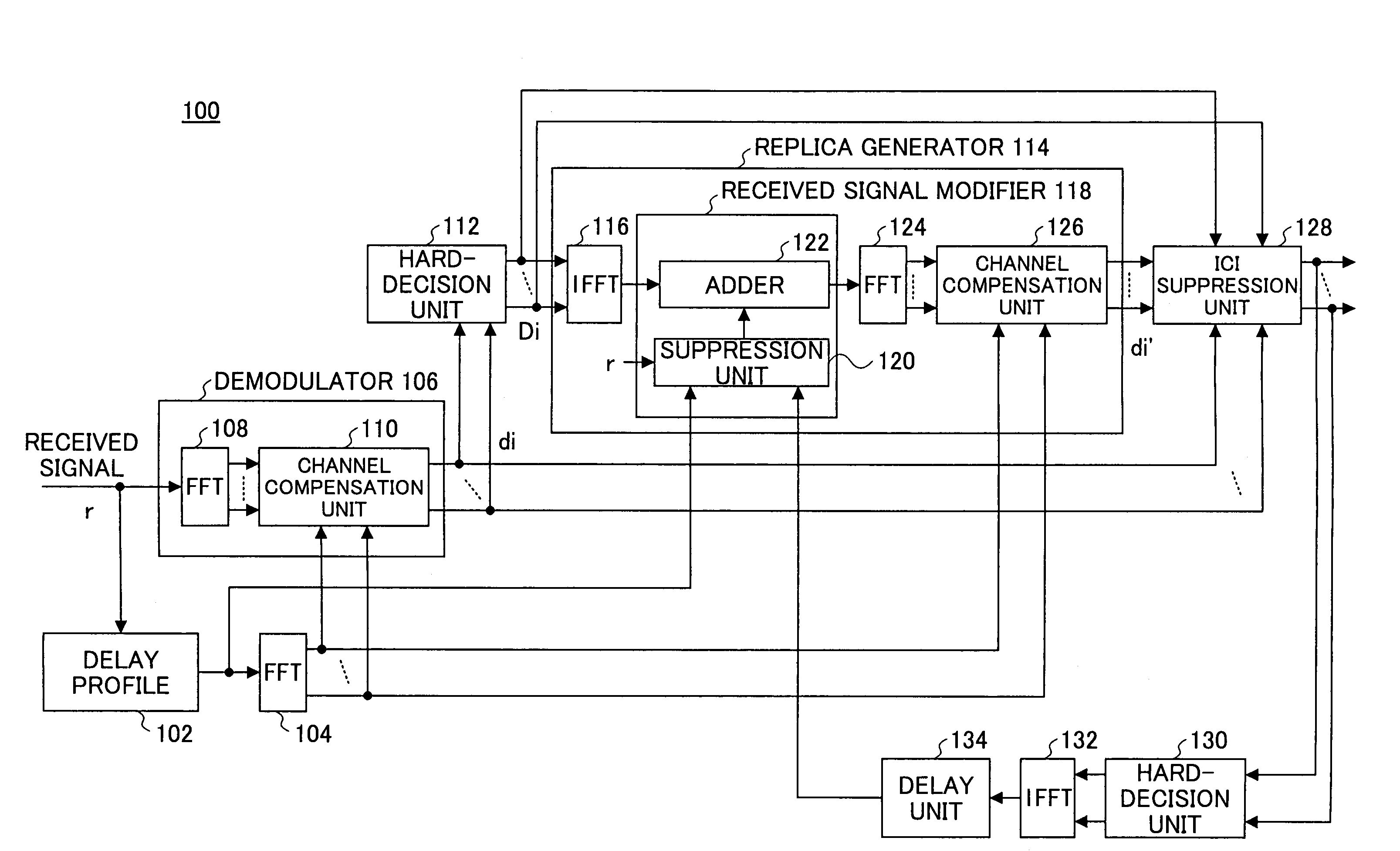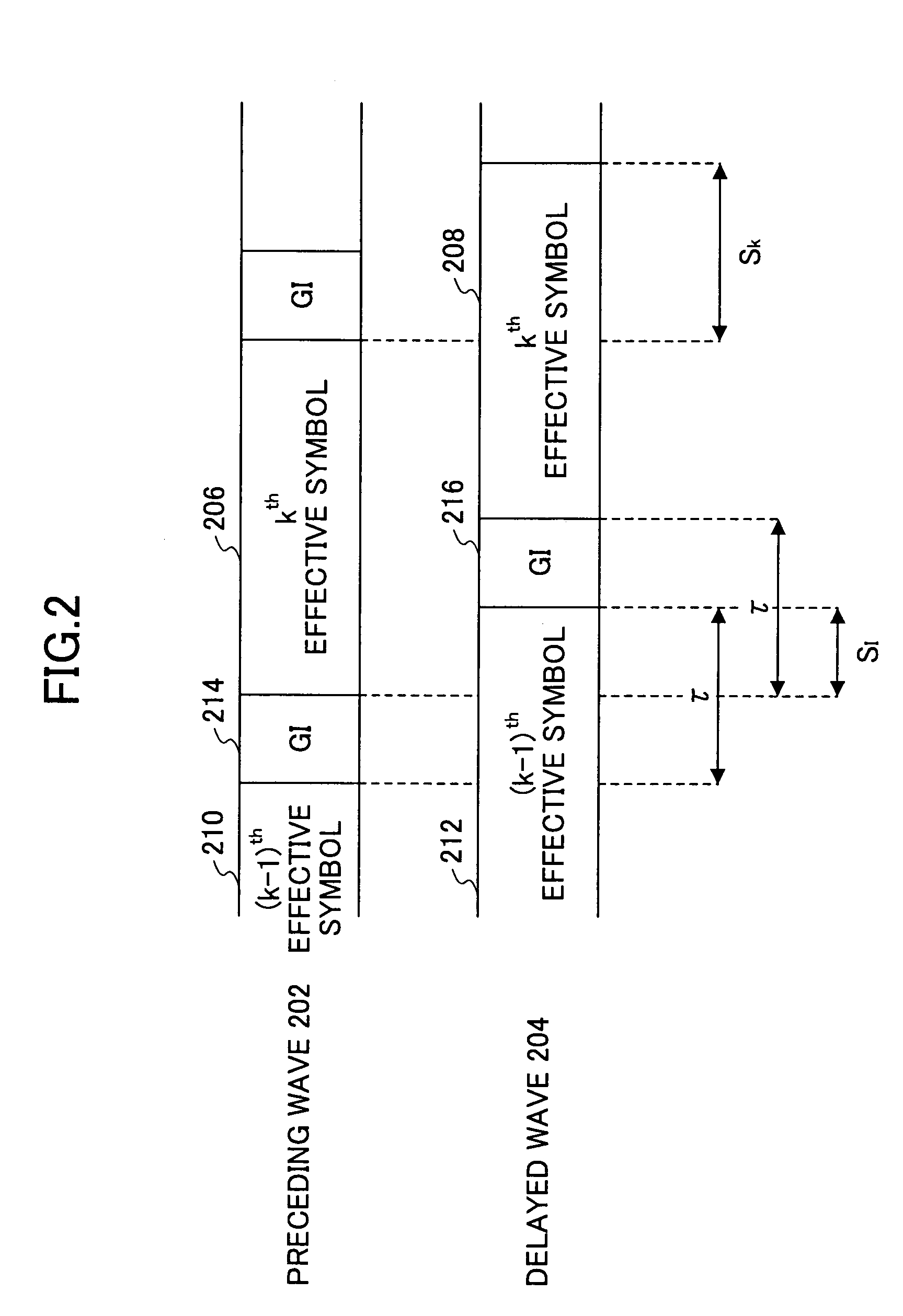Receiver which demodulates OFDM symbol
a demodulation and received signal technology, applied in the field of receiving signals, can solve the problems of reducing the effect of selective frequency fading, affecting the quality of the received signal, so as to reduce the interference of inter-symbols
- Summary
- Abstract
- Description
- Claims
- Application Information
AI Technical Summary
Benefits of technology
Problems solved by technology
Method used
Image
Examples
first embodiment
[0029]FIG. 1 is a functional block diagram of a receiver according to the present invention. The receiver 100 comprises a delay profile generator 102 which receives a signal which is transmitted by the OFDM method so as to generate a delay profile regarding the received signal. The output of the delay profile generator 102 is provided to the FFT 104 which performs FFT on the input signal. Besides, for brevity, the portions which perform the serial-to-parallel conversion and the parallel-to-serial conversion related to the FFT process and the below IFFT (Inverse FFT) process are omitted. The receiver 100 comprises a demodulator 106, the demodulator 106 comprising a FFT 108 which performs FFT on the received signal and a channel compensation unit 110 which is connected to the FFT 108. The channel compensation unit 110 based on the information from the delay profile 102 which is obtained via the FFT 104 adjusts per sub-carrier the amplitude and the phase of the signal from the FFT 108 ...
second embodiment
[0042]FIG. 3 illustrates a functional block diagram of a receiver according to the present invention. The receiver 300 comprises the delay profile generator 302 which receives the OFDM signal so as to generate the delay profile. The delay profile generator 302 is connected to the FFT 304 which performs FFT. Besides, for brevity, the portions which perform the serial-parallel conversion and / or the parallel-to-serial conversion related to FFT or IFFT are omitted. The receiver 300 comprises the demodulator 306, the demodulator 306 comprising the FFT 308 which performs FFT and the channel compensation unit 310 which is connected to the FFT 308. The channel compensation unit 310 adjusts the amplitude and the phase of the output signals of the FFT 308 based on the delay profile so as to output the demodulated signal per sub-carrier.
[0043]The receiver 300 comprises the hard-decision unit 312 which is connected to the demodulator 306, the hard-decision unit 312 making the hard decision per ...
third embodiment
[0058]FIG. 6 is a functional block diagram of a receiver according to the present invention. The receiver 600 comprises the delay profile generator 602 which generates the delay profile of the OFDM signal with the guard interval removed. The output of the delay profile generator 602 is provided to the FFT 604 which performs the FFT. The receiver 600 comprises the demodulator 606, the demodulator 606 performing FFT on the received signal and channel compensation using the delay profile so as to output a first demodulated signal A.
[0059]The receiver 600 comprises a first demodulated signal modifier 603, the first demodulated signal modifier 603 outputting a second demodulated signal B which modifies the first demodulated signal A. The receiver 600 comprises a second demodulated signal modifier 605, the second demodulated signal modifier 605 outputting a third demodulated signal C which modifies the second demodulated signal B. Furthermore, the receiver 600 comprises a third demodulate...
PUM
 Login to View More
Login to View More Abstract
Description
Claims
Application Information
 Login to View More
Login to View More - R&D
- Intellectual Property
- Life Sciences
- Materials
- Tech Scout
- Unparalleled Data Quality
- Higher Quality Content
- 60% Fewer Hallucinations
Browse by: Latest US Patents, China's latest patents, Technical Efficacy Thesaurus, Application Domain, Technology Topic, Popular Technical Reports.
© 2025 PatSnap. All rights reserved.Legal|Privacy policy|Modern Slavery Act Transparency Statement|Sitemap|About US| Contact US: help@patsnap.com



